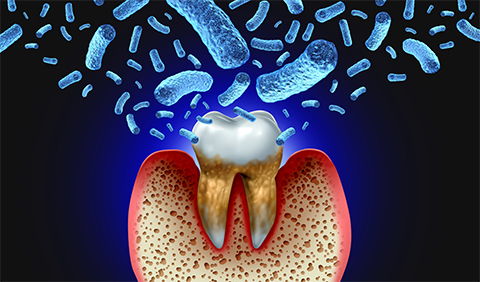Influenza gets help from gum disease bacteria
Scientists know that bacteria in the respiratory tract, such as specific Staphylococcus aureus strains, can boost influenza infectivity by supplying a protease that cleaves the viral spike protein hemagglutinin, a step that facilitates viral host entry. The bacterium Porphyromonas gingivalis causes periodontal disease and has been associated with severe cases of influenza, but scientists have not determined whether this connection involves hemagglutinin cleavage by a specific enzyme. In a recent article from the Journal of Biological Chemistry, Noriaki Kamio and a team at Nihon University in Japan investigated the link between P. gingivalis and influenza infectivity.

The authors used immunofluorescence microscopy and a canine kidney cell line to determine that an element in the supernatant of P. gingivalis culture enhanced cell-to-cell spread of influenza, similar to cells treated with trypsin protease. The researchers hypothesized that the supernatant contains a protease that can cleave viral hemagglutinin. They suspected that the gingipain cysteine proteases Rgp and Kgp produced by P. gingivalis could perform this function.
They tested the involvement of each protease by adding individual inhibitors of Rgp and Kgp to the supernatant and found that only the Rgp inhibitor blocked hemagglutinin cleavage. In addition, the authors showed that supernatant from a P. gingivalis strain lacking Rgp could not cleave hemagglutinin. They also performed a plaque assay to measure viral titers and found that the viral concentration was lower when cells were incubated with the bacterial strain missing Rgp. Therefore, they concluded that Rgp likely cleaves hemagglutinin and enhances viral replication.
The authors suggested that future studies using human respiratory cells and animal models will help unravel details of how P. gingivalis strengthens influenza infectivity. These results may help scientists pinpoint proteins in other bacteria that may promote respiratory viral spread.
Enjoy reading ASBMB Today?
Become a member to receive the print edition four times a year and the digital edition monthly.
Learn moreGet the latest from ASBMB Today
Enter your email address, and we’ll send you a weekly email with recent articles, interviews and more.
Latest in Science
Science highlights or most popular articles

The science of staying strong
Muscles power every movement, but they also tell the story of aging itself. Scientists are uncovering how strength fades, why some species resist it and what lifestyle and molecular clues could help preserve muscle health for life.

Bacteriophage protein could make queso fresco safer
Researchers characterized the structure and function of PlyP100, a bacteriophage protein that shows promise as a food-safe antimicrobial for preventing Listeria monocytogenes growth in fresh cheeses.

Building the blueprint to block HIV
Wesley Sundquist will present his work on the HIV capsid and revolutionary drug, Lenacapavir, at the ASBMB Annual Meeting, March 7–10, in Maryland.

Gut microbes hijack cancer pathway in high-fat diets
Researchers at the Feinstein Institutes for Medical Research found that a high-fat diet increases ammonia-producing bacteria in the gut microbiome of mice, which in turn disrupts TGF-β signaling and promotes colorectal cancer.

Mapping fentanyl’s cellular footprint
Using a new imaging method, researchers at State University of New York at Buffalo traced fentanyl’s effects inside brain immune cells, revealing how the drug alters lipid droplets, pointing to new paths for addiction diagnostics.

Designing life’s building blocks with AI
Tanja Kortemme, a professor at the University of California, San Francisco, will discuss her research using computational biology to engineer proteins at the 2026 ASBMB Annual Meeting.

